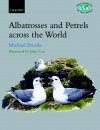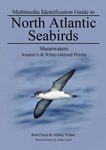Field / Identification Guide Flora / Fauna
Out of Print
By: Michael Brooke
499 pages, 16 col plates, 31 b/w illus, 168 maps
New volume in OUP's Bird Families of the World series
![Albatrosses and Petrels across the World Albatrosses and Petrels across the World]()
Click to have a closer look
About this book
Contents
Related titles
About this book
Visiting all the world's seas, the 125 species of albatross and petrel are the most oceanic and widespread of all seabirds. They nest on some of the remotest atolls and some of the bleakest ice-bound Antarctic islands on the planet. Petrels are now well studied ashore during breeding and, thanks to the rapid development of satellite tracking and similar techniques, when they are at sea. In this comprehensive and elegantly written book, Michael Brooke, who has visited some 40 countries in pursuit of birds, has brought together a wealth of information on all aspects of the biology of the species. He considers why Short-tailed Shearwaters nesting off Australia make regular 10,000 km round trips to Antarctica to harvest a single meal for their chicks, and he discusses the fearsome threat posed to most of the world's 21 albatross species by modern fishing techniques, especially long-lining. Includes 125 individual species accounts, each accompanied by a detailed distribution map. These accounts are the most accessible and up to date summaries of each species' biology currently available. Sixteen plates with colour paintings by John Cox further illuminate the text. The book also addresses the issue of conservation.
Contents
List of colour plates; List of abbreviations; Plan of the book and notes on reading the species accounts; PART I: GENERAL CHAPTERS; 1. An Introduction to the Petrels; 2. The Origins and Radiation of the Petrels; 3. The Colonial Imperative and its Impact on Behaviour; 4. The Build up to Laying; 5. Petrel Eggs: The Long Haul from Laying to Hatching; 6. The Chick's Passage from Egg to the High Seas; 7. Factors Influencing the Breeding Success of Petrels; 8. The Life History of Petrels; 9. How Does a Petrel Find Food at Sea: Some Developing Answers; 10. Perils for Petrels; PART II: SPECIES ACCOUNTS; References; Appendix 1: A summary of aspects of the breeding of the 79 species of Procellariidae; Appendix 2: Scienfific names of birds, mammals, reptiles, fish, insects, and plants mentioned in the text; Index
Customer Reviews
Field / Identification Guide Flora / Fauna
Out of Print
By: Michael Brooke
499 pages, 16 col plates, 31 b/w illus, 168 maps
New volume in OUP's Bird Families of the World series
The general chapters cover well-researched and abundantly referenced sections ... For anyone interested in, or working on petrels, this book provides the most comprehensive and up-to-date information available in a very readable style. Bird Study ... presents an updated view of our understanding of Petrel biology ... fresh look on the subject in light of recent discoveries. Avian and Poultry Biology Review OUP cannot be faulted for producing an attractive and worthwhile addition to ornithological texts. Albatrosses and Petrels Across the World give[s] an interesting and accessible account of the life style of these fascinating birds ... This book certainly helps to raise the profile of Petrels, which can only be a good thing in their longterm conservation. Avian and Poultry Biology Review Both authors combine scientific scholarship with a highly readable style, and this makes this book a pleasure to pour over. BBC Wildlife




































